Mechanism of Action of Isoflavone Derived from Soy-Based Tempeh as an Antioxidant and Breast Cancer Inhibitor via Potential Upregulation of miR-7-5p: A Multimodal Analysis Integrating Pharmacoinformatics and Cellular Studies
Abstract
1. Introduction
2. Materials and Methods
2.1. Apparatus and Materials
2.2. Soy-Based Tempeh Powder Preparation
2.3. Phytochemical Profiling via Untargeted Metabolomic Profiling
2.4. In Silico Study
2.4.1. Prediction of Bioactive Compound Activities and Druglikeness
2.4.2. Protein Target Identification and Analysis
2.4.3. Network Pharmacology Analysis
2.4.4. Molecular Docking Simulation
2.5. Antioxidant Activity against ABTS and FRAP
2.6. In Vitro Study on Cancer Cell Lines
2.6.1. Protein and miR-7-5p Expressions
2.6.2. MTT Assay
2.7. Data Analytics and Management
3. Results
3.1. List of Compounds from Metabolomic Profiling
3.2. Pa Score, Toxicity Prediction, Druglikeness, and Network Pharmacology Analysis
3.3. Docking Potency of SBT Compounds
3.4. SBT Scavenging Activity, Anticancer Capacity, and Safety
4. Discussion
5. Conclusions
Supplementary Materials
Author Contributions
Funding
Institutional Review Board Statement
Informed Consent Statement
Data Availability Statement
Conflicts of Interest
References
- Rusli, R.; Christeven, R.; Faruk, M. Cancer incidence and mortality in a tertiary hospital in Indonesia: An 18-year data review. Ethiop. J. Health Sci. 2023, 33, 515–522. [Google Scholar]
- Siegel, R.L.; Miller, K.D.; Wagle, N.S.; Jemal, A. Cancer statistics. CA Cancer J. Clin. 2023, 73, 17–48. [Google Scholar] [CrossRef] [PubMed]
- Primo, W.Q.S.P. National cancer institute and the 2023–2025 estimate—Cancer incidence in Brazil. Rev. Bras. Ginecol. Obs. 2023, 45, 1–2. [Google Scholar] [CrossRef] [PubMed]
- Obeagu, E.I.; Obeagu, G.U. Breast cancer: A review of risk factors and diagnosis. Medicine 2024, 103, e36905. [Google Scholar] [CrossRef] [PubMed]
- Francies, F.Z.; Hull, R.; Khanyile, R.; Dlamini, Z. Breast cancer in low-middle income countries: Abnormality in splicing and lack of targeted treatment options. Am. J. Cancer Res. 2020, 10, 1568–1591. [Google Scholar] [PubMed]
- Wang, J.; Wu, S.-G. Breast cancer: An overview of current therapeutic strategies, challenge, and perspectives. Breast Cancer 2023, 15, 721–730. [Google Scholar] [CrossRef]
- Burguin, A.; Diorio, C.; Durocher, F. Breast cancer treatments: Updates and new challenges. J. Pers. Med. 2021, 11, 808. [Google Scholar] [CrossRef]
- Nurkolis, F.; Qhabibi, F.R.; Yusuf, V.M.; Bulain, S.; Praditya, G.N.; Lailossa, D.G.; Al Mahira, M.F.N.; Prima, E.N.; Arjuna, T.; Permatasari, H.K.; et al. Anticancer properties of soy-based tempe: A proposed opinion for future meal. Front. Oncol. 2022, 12, 1054399. [Google Scholar] [CrossRef] [PubMed]
- Prativi, M.B.N.; Astuti, D.I.; Putri, S.P.; Laviña, W.A.; Fukusaki, E.; Aditiawati, P. Metabolite changes in Indonesian Tempe production from raw soybeans to over-fermented Tempe. Metabolites 2023, 13, 300. [Google Scholar] [CrossRef]
- Lima, A.; Oliveira, J.; Saúde, F.; Mota, J.; Ferreira, R. Proteins in soy might have a higher role in cancer prevention than previously expected: Soybean protein fractions are more effective MMP-9 inhibitors than non-protein fractions, even in cooked seeds. Nutrients 2017, 9, 201. [Google Scholar] [CrossRef]
- Romulo, A.; Surya, R. Tempe: A traditional fermented food of Indonesia and its health benefits. Int. J. Gastron. Food Sci. 2021, 26, 100413. [Google Scholar] [CrossRef]
- Sharifi-Rad, J.; Quispe, C.; Imran, M.; Rauf, A.; Nadeem, M.; Gondal, T.A.; Ahmad, B.; Atif, M.; Mubarak, M.S.; Sytar, O.; et al. Genistein: An integrative overview of its mode of action, pharmacological properties, and health benefits. Oxid. Med. Cell Longev. 2021, 2021, 3268136. [Google Scholar] [CrossRef] [PubMed]
- Sahin, I.; Bilir, B.; Ali, S.; Sahin, K.; Kucuk, O. Soy isoflavones in integrative oncology: Increased efficacy and decreased toxicity of cancer therapy. Integr. Cancer Ther. 2019, 18, 153473541983531. [Google Scholar] [CrossRef] [PubMed]
- Simbala, H.; Nurkolis, F.; Mayulu, N.; Rotty, L. New Discovery of COVID-19 Natural-Based Potential Antivirus Herbal Supplement Products from Pinang Yaki (Areca vestiaria) Extract: A Preliminary Study by Untargeted Metabolomic Profiling. F1000Research 2022, 10, 1021. [Google Scholar] [CrossRef] [PubMed]
- Druzhilovskiy, D.S.; Rudik, A.V.; Filimonov, D.A.; Gloriozova, T.A.; Lagunin, A.A.; Dmitriev, A.V.; Pogodin, P.V.; Dubovskaya, V.I.; Ivanov, S.M.; Tarasova, O.A.; et al. Computational platform Way2Drug: From the prediction of biological activity to drug repurposing. Russ. Chem. Bull. 2017, 66, 1832–1841. [Google Scholar] [CrossRef]
- Banerjee, P.; Eckert, A.O.; Schrey, A.K.; Preissner, R. ProTox-II: A webserver for the prediction of toxicity of chemicals. Nucleic Acids Res. 2018, 46, W257–W263. [Google Scholar] [CrossRef] [PubMed]
- Norinder, U.; Bergström, C.A.S. Prediction of ADMET properties. ChemMedChem 2006, 1, 920–937. [Google Scholar] [CrossRef] [PubMed]
- Dong, J.; Wang, N.-N.; Yao, Z.-J.; Zhang, L.; Cheng, Y.; Ouyang, D.; Lu, A.-P. ADMETlab: A platform for systematic ADMET evaluation based on a comprehensively collected ADMET database. J. Cheminform. 2018, 10, 29. [Google Scholar] [CrossRef] [PubMed]
- Gallo, K.; Goede, A.; Preissner, R.; Gohlke, B.O. SuperPred 3.0: Drug classification and target prediction—A machine learning approach. Nucleic Acids Res. 2022, 50, W726–W731. [Google Scholar] [CrossRef]
- Dunkel, M.; Günther, S.; Ahmed, J.; Wittig, B.; Preissner, R. SuperPred: Drug classification and target prediction. Nucleic Acids Res. 2008, 36, W55–W59. [Google Scholar] [CrossRef]
- Gfeller, D.; Grosdidier, A.; Wirth, M.; Daina, A.; Michielin, O.; Zoete, V. SwissTargetPrediction: A web server for target prediction of bioactive small molecules. Nucleic Acids Res. 2014, 42, W32–W38. [Google Scholar] [CrossRef]
- Asadzadeh, A.; Ghorbani, N.; Dastan, K. Identification of druggable hub genes and key pathways associated with cervical cancer by protein-protein interaction analysis: An in silico study. Int. J. Reprod. Biomed. 2023, 21, 809–818. [Google Scholar] [CrossRef]
- Sun, P.; Yang, Y.; Cheng, H.; Fu, S.; Liu, Y.; Qiu, Y.; Chen, H.; Zhang, J.; Zhou, H.; Shi, L.; et al. Integrated Analysis of Long Non-Coding RNA Expression Profiles in Glaesserella parasuis-Induced Meningitis: New Insight into Pathogenesis. Microbiol. Res. 2023, 14, 1427–1441. [Google Scholar] [CrossRef]
- Youn, J.S.; Kim, Y.J.; Na, H.J.; Jung, H.R.; Song, C.K.; Kang, S.Y.; Kim, J.Y. Antioxidant activity and contents of leaf extracts obtained from Dendropanax morbifera LEV are dependent on the collecting season and extraction conditions. Food Sci. Biotechnol. 2019, 28, 201–207. [Google Scholar] [CrossRef]
- Nurkolis, F.; Taslim, N.A.; Qhabibi, F.R.; Kang, S.; Moon, M.; Choi, J.; Choi, M.; Park, M.N.; Mayulu, N.; Kim, B. Ulvophyte Green Algae Caulerpa lentillifera: Metabolites Profile and Antioxidant, Anticancer, Anti-Obesity, and In Vitro Cytotoxicity Properties. Molecules 2023, 28, 1365. [Google Scholar] [CrossRef]
- Kucuk, O. Soy foods, isoflavones, and breast cancer. Cancer 2017, 123, 1901–1903. [Google Scholar] [CrossRef]
- Bintari, S.H.; Nugraheni, K. The potential of tempeh as a chemopreventive and chemotherapeutic agent targeting breast cancer cells. Pak. J. Nutr. 2017, 16, 743–749. [Google Scholar] [CrossRef]
- Limón, R.I.; Peñas, E.; Torino, M.I.; Martínez-Villaluenga, C.; Dueñas, M.; Frias, J. Fermentation enhances the content of bioactive compounds in kidney bean extracts. Food Chem. 2015, 172, 343–352. [Google Scholar] [CrossRef] [PubMed]
- Gumienna, M.; Szwengiel, A.; Górna, B. Bioactive components of pomegranate fruit and their transformation by fermentation processes. Eur. Food Res. Technol. 2016, 242, 631–640. [Google Scholar] [CrossRef]
- Tamam, B.; Syah, D.; Suhartono, M.T.; Kusuma, W.A.; Tachibana, S.; Lioe, H.N. Proteomic study of bioactive peptides from tempe. J. Biosci. Bioeng. 2019, 128, 241–248. [Google Scholar] [CrossRef]
- Wu, X.; Cheng, J.; Wang, X. Dietary antioxidants: Potential anticancer agents. Nutr. Cancer 2017, 69, 521–533. [Google Scholar] [CrossRef] [PubMed]
- Medina-Vera, I.; Gómez-de-Regil, L.; Gutiérrez-Solis, A.L.; Lugo, R.; Guevara-Cruz, M.; Pedraza-Chaverri, J.; Avila-Nava, A. Dietary strategies by foods with antioxidant effect on nutritional management of dyslipidemias: A systematic review. Antioxidants 2021, 10, 225. [Google Scholar] [CrossRef] [PubMed]
- Kadar, A.D.; Astawan, M.; Putri, S.P.; Fukusaki, E. Metabolomics-based study of the effect of raw materials to the end product of Tempe—An Indonesian fermented soybean. Metabolites 2020, 10, 367. [Google Scholar] [CrossRef]
- Rahmawati, D.; Astawan, M.; Putri, S.P.; Fukusaki, E. Gas chromatography-mass spectrometry-based metabolite profiling and sensory profile of Indonesian fermented food (tempe) from various legumes. J. Biosci. Bioeng. 2021, 132, 487–495. [Google Scholar] [CrossRef]
- Rawat, S.; Pathak, S.; Gupta, G.; Singh, S.K.; Singh, H.; Mishra, A.; Gilhotra, R. Recent updates on daidzein against oxidative stress and cancer. EXCLI J. 2019, 18, 950–954. [Google Scholar] [CrossRef] [PubMed]
- Murai, J.; Huang, S.-Y.N.; Renaud, A.; Zhang, Y.; Ji, J.; Takeda, S.; Morris, J.; Teicher, B.; Doroshow, J.H.; Pommier, Y. Stereospecific PARP trapping by BMN 673 and comparison with olaparib and rucaparib. Mol. Cancer Ther. 2014, 13, 433–443. [Google Scholar] [CrossRef]
- Watanabe, N.; Fujimoto, K.; Aoki, H. Antioxidant activities of the water-soluble fraction in tempeh-like fermented soybean (GABA-tempeh). Int. J. Food Sci. Nutr. 2007, 58, 577–587. [Google Scholar] [CrossRef] [PubMed]
- Ma, J.-H.; Qin, L.; Li, X. Role of STAT3 signaling pathway in breast cancer. Cell Commun. Signal 2020, 18, 33. [Google Scholar] [CrossRef] [PubMed]
- Zhu, Y.; Yao, Y.; Shi, Z.; Everaert, N.; Ren, G. Synergistic effect of bioactive anticarcinogens from soybean on anti-proliferative activity in MDA-MB-231 and MCF-7 human breast cancer cells in vitro. Molecules 2018, 23, 1557. [Google Scholar] [CrossRef]
- Ghafouri-Fard, S.; Khanbabapour Sasi, A.; Abak, A.; Shoorei, H.; Khoshkar, A.; Taheri, M. Contribution of miRNAs in the pathogenesis of breast cancer. Front. Oncol. 2021, 11, 768949. [Google Scholar] [CrossRef]
- Maiuolo, J.; Gliozzi, M.; Carresi, C.; Musolino, V.; Oppedisano, F.; Scarano, F.; Nucera, S.; Scicchitano, M.; Bosco, F.; Macri, R.; et al. Nutraceuticals and cancer: Potential for natural polyphenols. Nutrients 2021, 13, 3834. [Google Scholar] [CrossRef]
- Sadhu, P.; Rathod, F.; Kumari, M.; Shah, N.; Talele, C.; Aundhia, C.; Shah, N. Exploring herbal remedies for skin cancer: A comprehensive review. J. Adv. Zool. 2024, 45, 951. [Google Scholar] [CrossRef]
- Luo, M.; Zhou, L.; Huang, Z.; Li, B.; Nice, E.C.; Xu, J.; Huang, C. Antioxidant therapy in cancer: Rationale and progress. Antioxidants 2022, 11, 1128. [Google Scholar] [CrossRef] [PubMed]
- Haffani, Y.Z.; Louati, K.; Tilki, E.K.; Mami, N.B.; Mbarek, S.; Halim, N.B.; Boudhrioua, N.; Ozturk, Y.; Chekir, R.B.C. Anti-tumoral activity of Allium roseum compounds on breast cancer cells MCF7 and MDA-MB231. Adv. Tradit. Med. 2024, 24, 323–333. [Google Scholar] [CrossRef]
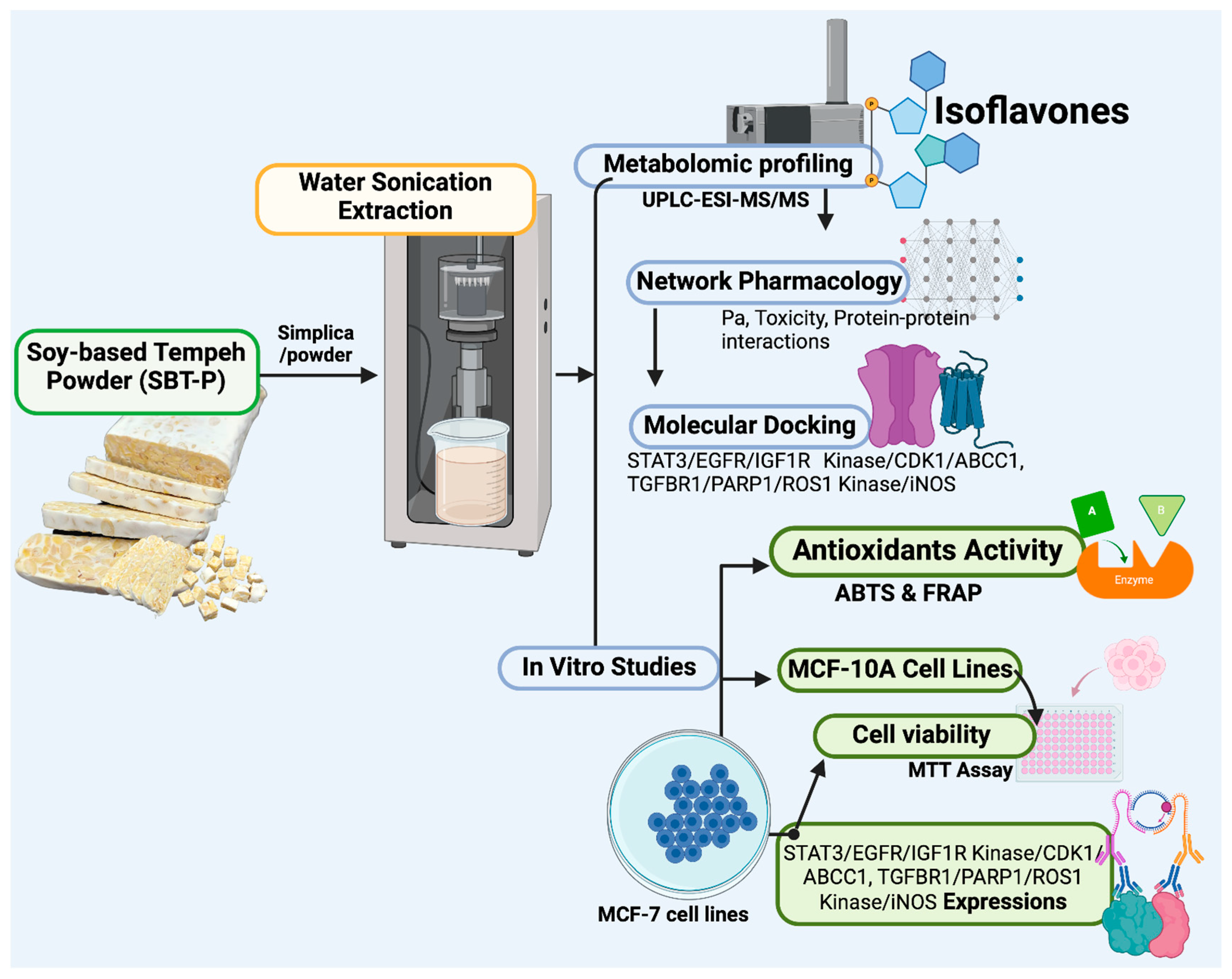
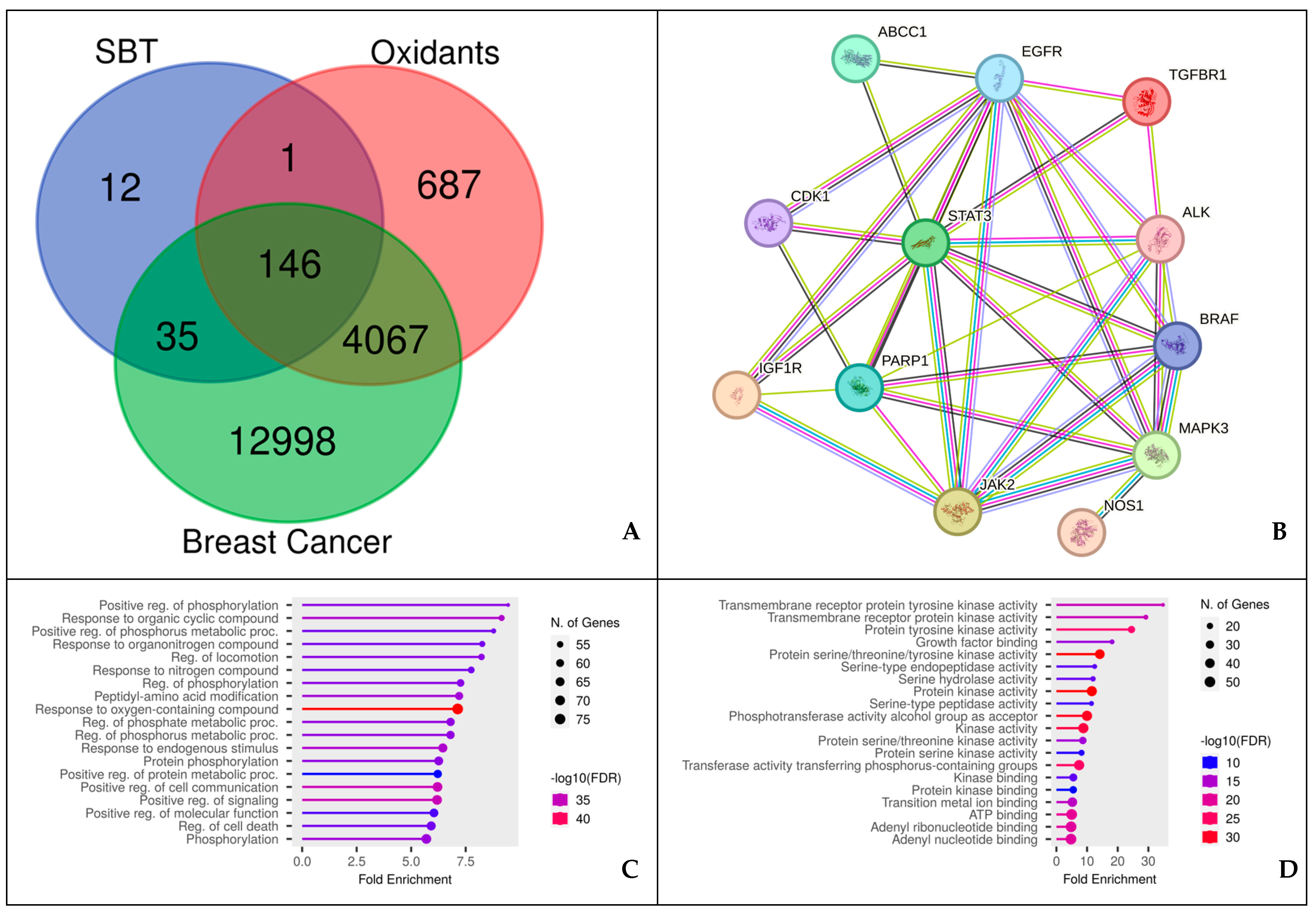
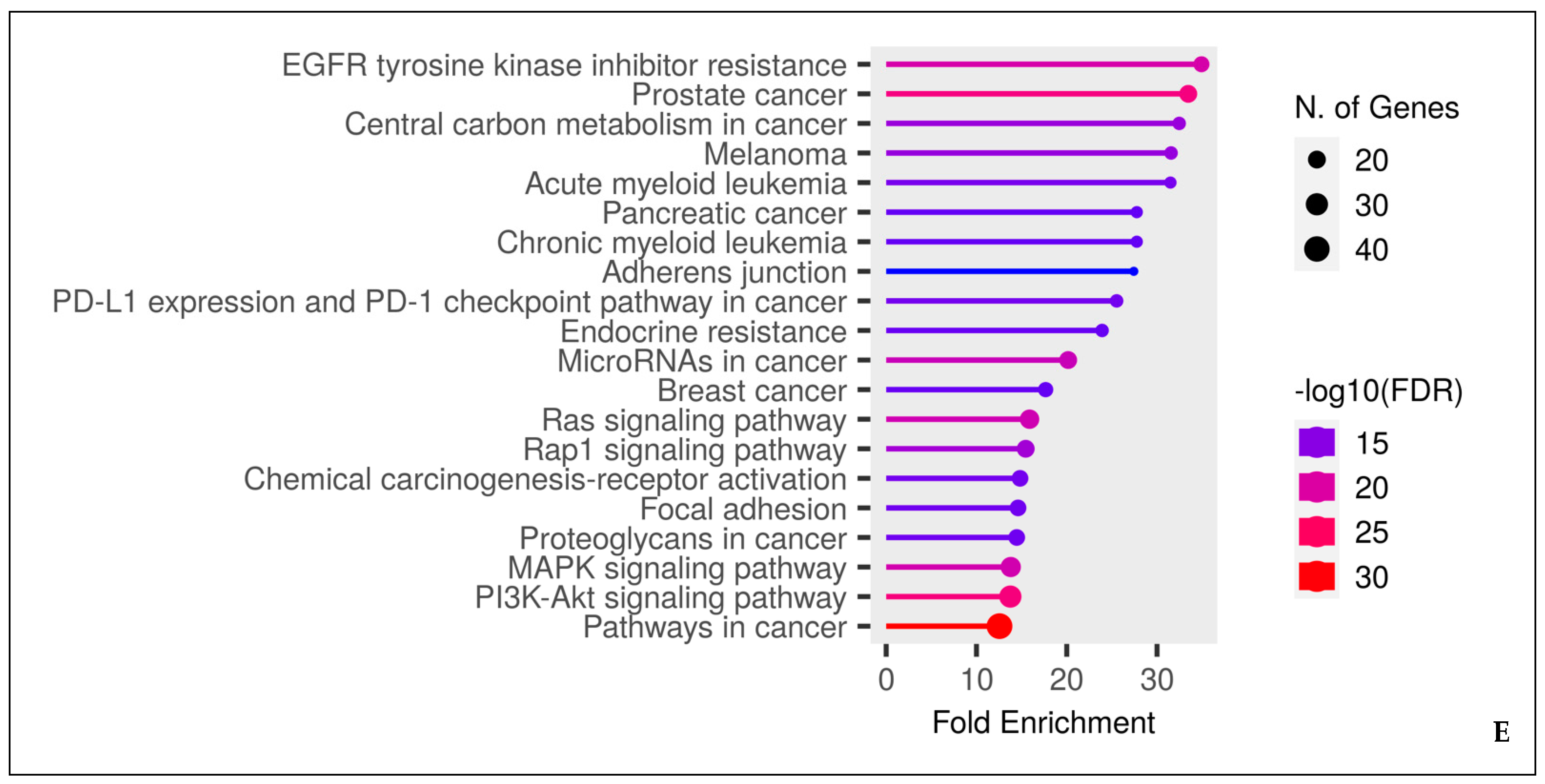


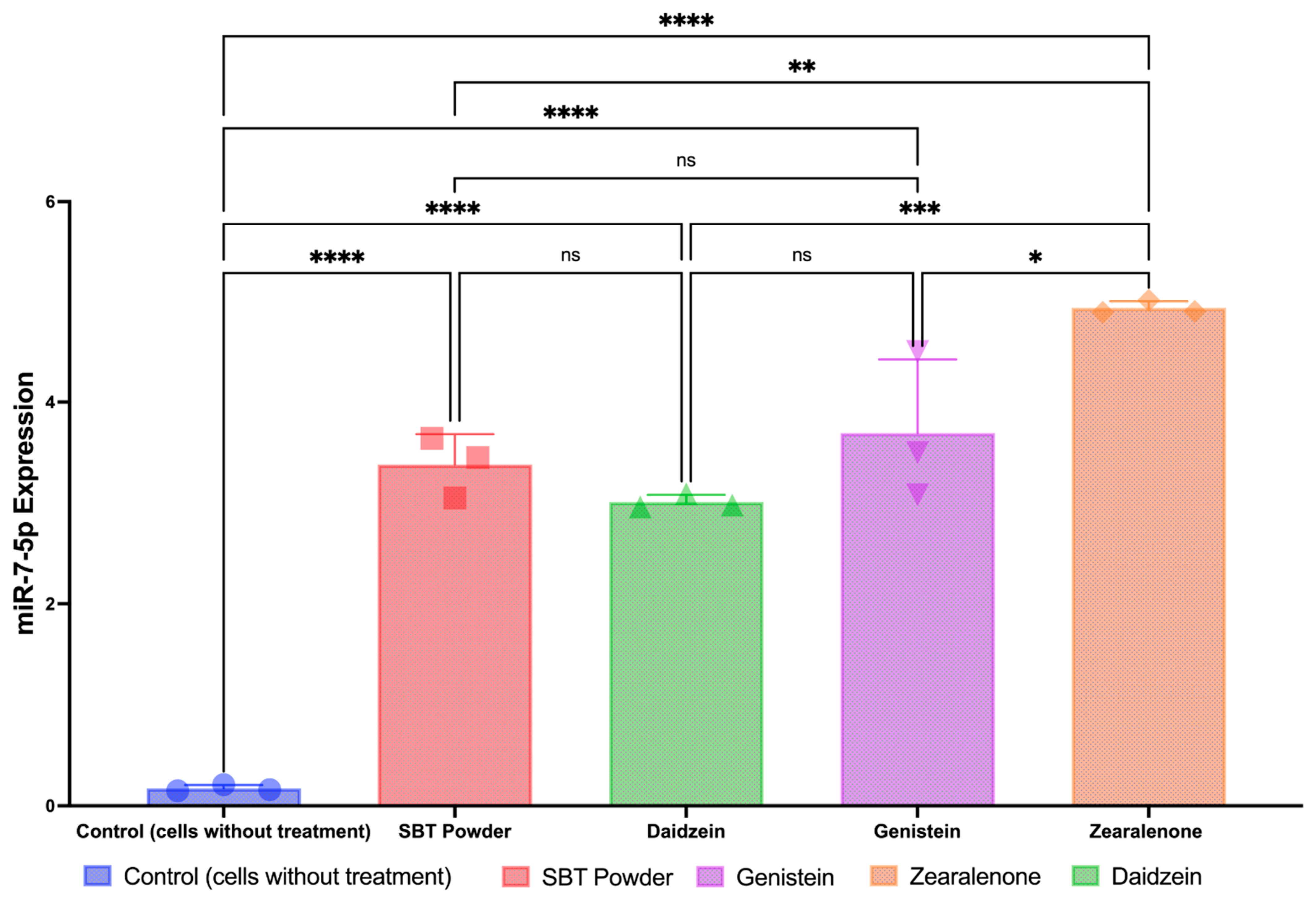
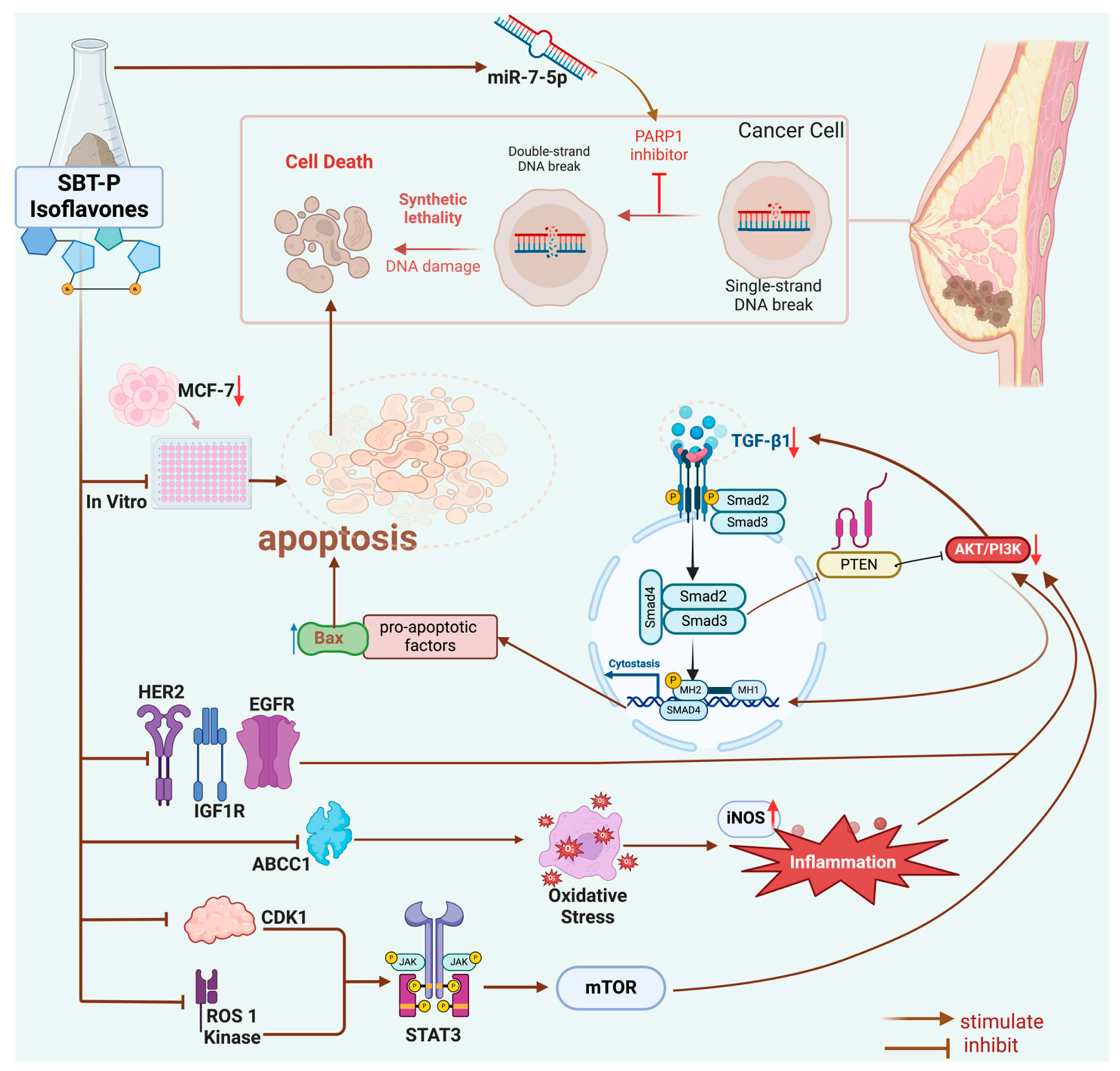
| No | Type | Name | Molecular Formula | PubChem/CAS ID | m/z | tR |
|---|---|---|---|---|---|---|
| C1 | Phytoestrogenic | Daidzein | C15H10O4 | 5281708/486-66-8 | 254.2000 | 2.69 |
| C2 | Soy isoflavones | Genistein | C15H10O5 | 5280961/446-72-0 | 270.2395 | 2.81 |
| C3 | Mycoestrogenic | Zearalenone | C18H22O5 | 5281576/17924-92-4 | 318.3900 | 1.98 |
| Code | Pa Score * | Toxicity Model Computation Analysis ** | Druglikeness *** | |||
|---|---|---|---|---|---|---|
| HIF1A Expression Inhibitor | Predicted LD50 (mg/kg BW) | Toxicity Class | Lipinski Rule | Pfizer Rule | GSK | |
| C1 | 0.915 | 2,430 | 5 | Accepted | Accepted | Accepted |
| C2 | 0.939 | 2,500 | 5 | Accepted | Accepted | Accepted |
| C3 | 0.871 | 500 | 4 | Accepted | Accepted | Accepted |
| Name | Degree | Betweenness Centrality | Closeness Centrality | Overall Score | Pathway |
|---|---|---|---|---|---|
| STAT3 | 19 | 0.50293053 | 0.52054795 | 20.0234785 | Immune cells, and adipocytes in the tumor microenvironment, Warburg effect, oxidative phosphorylation, STAT3 signaling regulates glycolysis, ROS production or ROS1 kinase, lipid, and glutamine metabolism in cancer cells |
| EGFR | 14 | 0.12136164 | 0.43428571 | 14.5556474 | EGFR promotes NF-kappa-B activation and cell proliferation, ALK, and ROS1 mutations |
| IGF1R | 6 | 0.0216914 | 0.38383838 | 6.40552979 | PI3K/AKT and MAPK signaling pathways and HIF-1α (oxygen-sensitive subunit of HIF1) signaling |
| CDK1 | 4 | 0.0174118 | 0.32900433 | 4.34641613 | CDK1 mediates the activation of the FBXO28 ubiquitin ligase and promotes MYC-driven transcription and tumorigenesis |
| ABCC1 | 1 | 1 | 1 | 3 | ABCC1, ABCC4 play an essential physiological role in its development, independent of their role in multidrug resistance, affecting, migration cellular proliferation, and differentiation |
| TGFBR1 (ALK5) | 1 | 1 | 0.3220339 | 2.3220339 | Poly(ADP-ribose) polymerase-1 (PARP-1) regulates TGF-β receptor I (TβRI) expression and ALK5/SMAD2/3 signaling in regulating NOX expression |
| PARP1 | 2 | 0.02631579 | 0.28358209 | 2.30989788 | MiR-7-5p-mediated downregulation of PARP1 impacts the repair of DNA homologous recombination, NF-κB signaling pathway, and the inhibition of poly(ADP-ribose) polymerase (PARP) activity induces synthetic death in mutated BRCA1/2 cancer |
| Receptors/Proteins (PDB ID) | Gibbs Free Energy (ΔG; kcal/mol) | ||||
|---|---|---|---|---|---|
| C1 | C2 | C3 | Control/Talazoparib | Control/S-ibuprofen | |
| STAT3 (1BG1) | −8.1 | −8 | −7.1 | −7 | |
| EGFR (1M17) | −8.2 | −7.7 | −7.5 | −7.4 | |
| IGF1R kinase (3LWO) | −8.8 | −8.6 | −9.4 | −8.5 | |
| CDK1 (6GU7) | −7.6 | −7.6 | −8.4 | −8.2 | |
| ABCC1 (2CBZ) | −6.7 | −6.9 | −7.1 | −6.7 | |
| TGFBR1/ALK5 (5QIK) | −9.3 | −9.7 | −7.5 | −7.2 | |
| PARP1 (4R6E) | −8 | −8.1 | −9.6 | −8.4 | |
| ROS1 kinase (3ZBF) | −7.1 | −7.1 | −8.1 | −8 | |
| iNOS (3E7G) | −9.8 | −9.8 | −8.8 | −8.6 | |
| No | Samples | MCF-7 Cancer Line | MCF-10A Normal Line |
|---|---|---|---|
| 1 | SBT-P | 419.0045 | 1995.5099 |
| 2 | Genistein | 50.7880 | 1065.0034 |
| 3 | Daidzein | 45.8998 | 998.6090 |
| 4 | Zearalenone | 39.0887 | 1010.4661 |
| 5 | Control mitoxantrone | 21.0555 | 18.0950 |
| 6 | Control talazoparib | 8.0905 | 20.1908 |
Disclaimer/Publisher’s Note: The statements, opinions and data contained in all publications are solely those of the individual author(s) and contributor(s) and not of MDPI and/or the editor(s). MDPI and/or the editor(s) disclaim responsibility for any injury to people or property resulting from any ideas, methods, instructions or products referred to in the content. |
© 2024 by the authors. Licensee MDPI, Basel, Switzerland. This article is an open access article distributed under the terms and conditions of the Creative Commons Attribution (CC BY) license (https://creativecommons.org/licenses/by/4.0/).
Share and Cite
Nurkolis, F.; Taslim, N.A.; Lee, D.; Park, M.N.; Moon, S.; Hardinsyah, H.; Tjandrawinata, R.R.; Mayulu, N.; Astawan, M.; Tallei, T.E.; et al. Mechanism of Action of Isoflavone Derived from Soy-Based Tempeh as an Antioxidant and Breast Cancer Inhibitor via Potential Upregulation of miR-7-5p: A Multimodal Analysis Integrating Pharmacoinformatics and Cellular Studies. Antioxidants 2024, 13, 632. https://doi.org/10.3390/antiox13060632
Nurkolis F, Taslim NA, Lee D, Park MN, Moon S, Hardinsyah H, Tjandrawinata RR, Mayulu N, Astawan M, Tallei TE, et al. Mechanism of Action of Isoflavone Derived from Soy-Based Tempeh as an Antioxidant and Breast Cancer Inhibitor via Potential Upregulation of miR-7-5p: A Multimodal Analysis Integrating Pharmacoinformatics and Cellular Studies. Antioxidants. 2024; 13(6):632. https://doi.org/10.3390/antiox13060632
Chicago/Turabian StyleNurkolis, Fahrul, Nurpudji Astuti Taslim, Dain Lee, Moon Nyeo Park, Seungjoon Moon, Hardinsyah Hardinsyah, Raymond Rubianto Tjandrawinata, Nelly Mayulu, Made Astawan, Trina Ekawati Tallei, and et al. 2024. "Mechanism of Action of Isoflavone Derived from Soy-Based Tempeh as an Antioxidant and Breast Cancer Inhibitor via Potential Upregulation of miR-7-5p: A Multimodal Analysis Integrating Pharmacoinformatics and Cellular Studies" Antioxidants 13, no. 6: 632. https://doi.org/10.3390/antiox13060632
APA StyleNurkolis, F., Taslim, N. A., Lee, D., Park, M. N., Moon, S., Hardinsyah, H., Tjandrawinata, R. R., Mayulu, N., Astawan, M., Tallei, T. E., & Kim, B. (2024). Mechanism of Action of Isoflavone Derived from Soy-Based Tempeh as an Antioxidant and Breast Cancer Inhibitor via Potential Upregulation of miR-7-5p: A Multimodal Analysis Integrating Pharmacoinformatics and Cellular Studies. Antioxidants, 13(6), 632. https://doi.org/10.3390/antiox13060632











